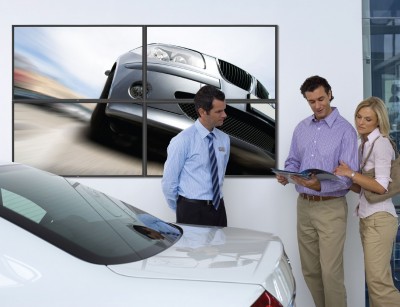Locations for installations
The issue of where to install digital signs in a retail environment may seem at first like a simple consideration, but requires strategic planning that too many organizations fail to tackle. The retailer needs to consider where digital signage can get the most bang for the buck and how, specifically, sales are going to be driven.
In some cases, screens will be mounted just inside the doors of the store. In others, they are more effective in or near specific zones, like clothing fitting rooms. These installation decisions are contingent on where the retailer feels its customers are most likely to make purchasing decisions about its products.
The retail difference
As mentioned, the use of retail digital signage differs noticeably from applications in other industries. Indeed, there is much retailers can learn from those differences.

Some of the more progressive vendors are installing multi-screen video walls for a greater ‘wow’ factor.
In an airport, for example, digital signage is used to deliver flight information, along with some third-party advertising, news and other passive content. In a retail store, on the other hand, digital signage is usually 100 per cent dedicated to building the store’s brand and that of its products. Ads for Best Buy will not show up, for instance, on a Walmart screen network.
Another difference is customers tend to see a lot more dynamic content in retail settings than elsewhere, whether this entails full-motion video, animation or basic motion, potentially with audio content, as well. In fact, retail digital signage is nearly unique today in using background music, brand-specific sound effects, spoken word and other audio elements. These have proven compelling in helping drive sales.
Given these factors, as well as the diversity of potential content, one of the greatest opportunities anywhere in the digital signage industry has been the ability to affect retail sales. When a typical big-box store incorporates entertaining video and messaging to pique interest in its products, for example, it can showcase different brands of products and services to get consumers interested in them.
That scenario does not exist in quick-service restaurants (QSRs), by comparison, where digital signs may also be used for entertainment, but primarily take the form of less motion-heavy menu boards, featuring promotions to help trigger the upselling of food and drink items. With this different approach, they are less focused on conveying an experience related to their products.
Today’s progressive retailers are putting digital screens up where they can increase sales of certain items and help trigger impulse buying. Some are also installing video walls for more of a ‘wow’ factor within their store.
On the interactivity front, they are using both customized large-screen applications and smaller kiosks to allow consumers a measure of control. Customers’ smart phones can scan codes for coupons and special promotions, for example, and other deals may be offered through Twitter or Facebook. Compared to other sectors, interactivity is already becoming a central approach for retailers in terms of building customer relationships and achieving further growth.





